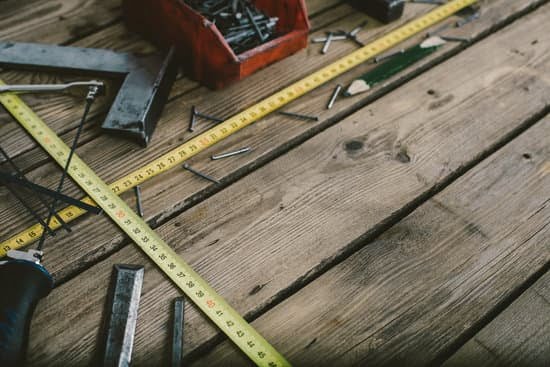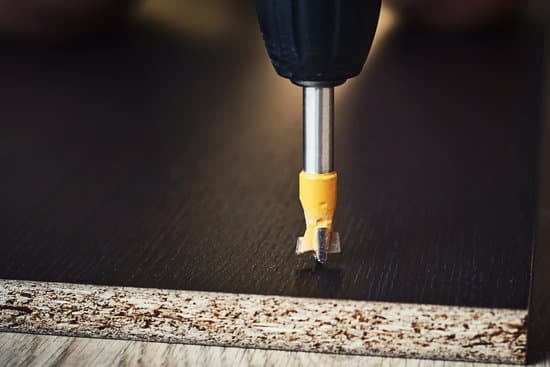Are you tired of uneven and misshapen circles ruining the quality of your woodworking projects? Knowing how to measure and draw circles accurately can make a significant difference in the overall outcome of your work.
By mastering this crucial skill, you can ensure that your furniture, decorative pieces, and other woodworking projects have a professional and polished finish. In this article, we will delve into the essential knowledge and techniques for measuring and drawing circles in woodworking to help you improve the precision and quality of your creations.
One of the fundamental aspects of woodworking is the ability to measure and draw precise circles. Whether you are creating tabletops, intricate designs, or decorative elements, having perfectly shaped circles is essential. With the right tools and methods, you can elevate the standard of your projects and enhance their visual appeal. This article will provide practical guidance on selecting the appropriate tools for circle measurement and drawing, as well as exploring different methods to achieve accurate results.
In addition to discussing the tools needed for this task, we will also cover various methods for measuring and drawing circles, such as using a compass, trammel points, or string method. Each method has its advantages and drawbacks, so understanding these nuances will enable you to choose the most suitable approach for your specific woodworking needs. By gaining expertise in these techniques, you will have greater control over the precision and consistency of your circle designs.
Tools Needed
When it comes to woodworking, accurately measuring and drawing circles is crucial for achieving high-quality results in your projects. To accomplish this, there are various tools that you will need to have on hand. These tools will allow you to measure and draw circles with precision and accuracy, ensuring that your woodworking projects turn out as intended.
Compasses
One of the most common tools used for measuring and drawing circles in woodworking is a compass. This tool consists of two legs with a pointed end and a pencil or marking point at the other end. By adjusting the distance between the two points, you can easily create circles of different sizes with ease.
Dividers
Another essential tool for accurately measuring and drawing circles is a set of dividers. Dividers are similar to compasses but do not have a pencil or marking point attached. Instead, they are used to transfer measurements from one location to another with precision.
Marking Gauges
In addition to compasses and dividers, marking gauges are also valuable tools for woodworking when it comes to drawing circles. They consist of a beam and a fence which allows you to set specific measurements for accurately transferring those measurements onto your wood surface.
By using these tools in combination with each other, woodworkers can effectively measure and draw circles on their woodworking projects with accuracy and precision. Whether creating decorative elements or functional parts, having these tools readily available will greatly improve the quality of your work.
Choosing the Right Method
When it comes to woodworking, knowing how to accurately measure and draw circles is an essential skill that can significantly improve the quality of your projects. There are several methods for measuring and drawing circles, each with its own pros and cons. Choosing the right method for your specific project can make a big difference in the final result.
Here are some different methods for measuring and drawing circles:
- Using a compass: Compasses are a classic tool for drawing circles in woodworking. They consist of two legs, one with a pointed end for anchoring to the wood and another with a pencil or other marking tool. Compasses are great for smaller circles and offer precision in measurements.
- Trammel points: Trammel points are adjustable tools that allow you to create large circles with ease. They consist of two metal points connected by a bar, which can be adjusted to create circles of various sizes. Trammel points are ideal for drawing larger circles or arcs.
- String method: The string method involves using a length of string attached to a fixed point on the wood and an anchor point for the pencil at the desired radius. This method is versatile and can be used for creating large or irregularly shaped circles.
Each method has its own advantages and drawbacks, so it’s important to consider the specific requirements of your project when choosing which method to use.
Ultimately, understanding how to measure and draw circles using various tools and methods will give you the flexibility to tackle any woodworking project that comes your way. With practice, you’ll become more confident in selecting the right method for different circle-drawing scenarios, leading to professional-looking results every time.
Measuring the Circle
Measuring a circle accurately is essential for ensuring the success of woodworking projects. Whether you are creating a tabletop, a decorative piece, or any other circular element, having the right measurements is crucial. In this section, we will provide step-by-step instructions on how to measure the diameter or radius of a circle accurately using the chosen method.
The first step in measuring a circle is to select the appropriate method for your project. As mentioned in the previous section, there are several options available, including using a compass, trammel points, or string method. Once you have chosen your preferred method, it’s time to take accurate measurements.
If you are using a compass, open it to the desired radius and firmly place one end at the center point of the circle. Rotate the compass 360 degrees to mark out the full circumference of the circle. For trammel points or string methods, follow similar steps by securing one end at the center point and marking out the circumference with precision.
It’s important to double-check your measurements and ensure that they are accurate before proceeding to draw the circle on your woodworking project. Taking the time to measure carefully will save you from potential errors and rework in later stages of your project. Mastering this skill will undoubtedly enhance the overall quality of your woodworking endeavors.
Drawing the Circle
Transferring Measurements
Once you have accurately measured the diameter or radius of the circle using your chosen method, the next step is to transfer these measurements onto the wood. This can be done by marking the center point of the circle and then drawing a line from that point to the edge of the circle. Or, you can use a compass or trammel points to directly mark the circumference of the circle on the wood.
Drawing Techniques
When it comes to actually drawing the circle on the wood, it is important to use the right technique to ensure a perfect result. If you are using a compass or trammel points, make sure they are firmly secured in place so that they do not shift while you are drawing. Take your time and draw the circle with steady, even pressure to achieve a smooth and uniform line.
Checking for Accuracy
After drawing the circle, always double-check your work for accuracy. Use a ruler to measure different points around the circumference of the circle and ensure that they all match up with your original measurements. This will help you catch any discrepancies and make necessary adjustments before cutting or further working with the wood.
By following these detailed steps and techniques, you can confidently transfer measurements onto wood and draw perfect circles for your woodworking projects. Remember to practice these skills regularly to improve your precision and achieve flawless results in your creations.
Common Mistakes to Avoid
Measuring and drawing circles in woodworking may seem like a simple task, but it is essential to pay attention to detail and accuracy to achieve the best results. Unfortunately, many woodworkers often make some common mistakes when measuring and drawing circles that can affect the quality of their projects. By being aware of these mistakes and learning how to avoid them, woodworkers can significantly improve their woodworking skills.
One of the most common mistakes when measuring a circle is inaccurately determining the diameter or radius. Whether using a compass, trammel points, or string method, it is crucial to take precise measurements to ensure that the circle is drawn correctly on the wood. Additionally, not properly securing the measuring tool in place can lead to inaccurate measurements and ultimately affect the final outcome of the project.
When it comes to drawing the circle on wood, another common mistake is applying too much or too little pressure with the pencil or marking tool. This can result in an uneven or distorted circle shape. Furthermore, not holding the marking tool perpendicular to the wood surface can also lead to inaccuracies in drawing the circle.
To avoid these mistakes, woodworkers should always double-check their measurements and securely fasten their measuring tools in place before marking or cutting any wood. It’s also crucial to maintain a steady hand while drawing the circle and apply consistent pressure with the marking tool for a smooth and even line.
| Common Mistakes | How to Avoid Them |
|---|---|
| Inaccurate measurements of diameter/radius | Double-check measurements; secure measuring tools |
| Uneven pressure when drawing | Maintain steady hand; apply consistent pressure |
| Not holding marking tool perpendicular | Ensure proper angle; use guideline if necessary |
By being mindful of these common mistakes and utilizing techniques for avoiding them, woodworkers can improve their ability to measure and draw perfect circles for their woodworking projects.
Practice Exercises
When it comes to woodworking, being able to measure and draw circles accurately is an essential skill. It can make a significant difference in the quality and overall aesthetic of your projects. Practice exercises can help you improve your circle-drawing skills and gain confidence in your abilities.
One simple practice exercise is to start by drawing circles of various sizes on a piece of scrap wood using a compass or trammel points. This will help you get comfortable with controlling the tool and drawing consistent circles. You can also try drawing concentric circles to practice precision and accuracy.
Another useful exercise is to challenge yourself to draw circles freehand. While this may seem daunting at first, it’s a great way to improve your hand-eye coordination and gain a better understanding of how different factors, such as pressure and angle, affect the shape of the circle.
For more advanced practice, consider using different methods for measuring and drawing circles. Experiment with using string method or marking gauges to see which technique works best for you. This will not only improve your skills but also broaden your understanding of the various tools and methods available for circle-drawing in woodworking.
By regularly practicing these exercises, you’ll steadily build your confidence and proficiency in measuring and drawing circles on woodworking projects. Remember that mastery takes time and patience, so don’t be discouraged by any initial difficulty. With dedication and consistent practice, you’ll soon become adept at this essential skill.
Advanced Techniques
When it comes to woodworking, precision is key, especially when dealing with circular shapes. While traditional methods like compasses and trammel points can produce accurate results, advanced techniques using modern tools such as a router or CNC machine can take the precision of circle measurement and drawing to a whole new level.
Using a Router:
Routers are versatile power tools commonly used for shaping edges, creating grooves, and cutting patterns. They can also be used to accurately cut circles in wood. By attaching a circle-cutting jig to the base of the router, woodworkers can create perfect circles with ease. The adjustable radius of the jig allows for precise measurements and consistent results. This technique is particularly useful for creating circular tabletops, decorative inlays, or making wooden wheels for projects.
Using a CNC Machine:
Computer Numerical Control (CNC) machines are another advanced tool that can be employed for measuring and drawing circles in woodworking. These machines use computer-aided design (CAD) software to precisely control the movement of cutting tools along multiple axes.
By inputting the exact dimensions of the desired circle into the software, woodworkers can program the CNC machine to accurately cut or carve out circular shapes with incredible accuracy. This method is ideal for complex designs or batch production of identical circular components.
It’s important to note that while these advanced techniques offer unparalleled precision, they also require specialized tools and knowledge of their operation. Routers and CNC machines can be expensive investments, so it’s crucial to weigh their benefits against your specific woodworking needs before incorporating them into your projects.
| Advanced Technique | Use |
|---|---|
| Router | Accurate cutting of circles in wood like tabletops or wheels |
| CNC Machine | Precision cutting or carving of complex circular shapes using CAD software |
Conclusion
In conclusion, mastering the skill of measuring and drawing circles in woodworking is crucial for achieving precision and accuracy in your projects. As discussed throughout this guide, the tools needed for this task are readily available, and with the right methods, anyone can learn to measure and draw circles effectively. Whether you choose to use a compass, trammel points, or any other method, the key is to practice and perfect your technique.
It’s important to remember that mistakes are part of the learning process, but by being aware of common errors and practicing simple exercises, you can improve your circle-drawing skills. As you become more confident in your abilities, consider exploring advanced techniques like using a router or CNC machine for even more precise results. Ultimately, mastering the art of measuring and drawing circles will elevate the quality of your woodworking projects and set you apart as a skilled craftsman.
So don’t be discouraged if it takes time to perfect your technique – keep practicing. The ability to accurately measure and draw circles is a fundamental skill that every woodworker should strive to master. With dedication and perseverance, you’ll soon find yourself creating flawless circles with ease. Remember, perfection may not come overnight, but with patience and commitment, you can become proficient in this essential aspect of woodworking.
Frequently Asked Questions
How Do You Measure a Circle in Woodworking?
In woodworking, a circle can be measured using a compass or a circle layout tool. To measure the diameter of the circle, place the compass point on one edge of the circle and extend the pencil to the other edge.
How Do You Measure and Draw a Circle?
Measuring and drawing a circle requires the use of a compass or a circular template. With a compass, place the pivot point on the center of the circle and set the radius, then draw around the pivot point.
How Do You Mark a Perfect Circle on Wood?
Marking a perfect circle on wood can be achieved by using a trammel or beam compass. Set the desired radius on the trammel and pivot it around to mark out the circumference of the circle accurately. Alternatively, use a circular template and trace around it onto the wood surface.

Hi everyone! I’m a woodworker and blogger, and this is my woodworking blog. In my blog, I share tips and tricks for woodworkers of all skill levels, as well as project ideas that you can try yourself.





